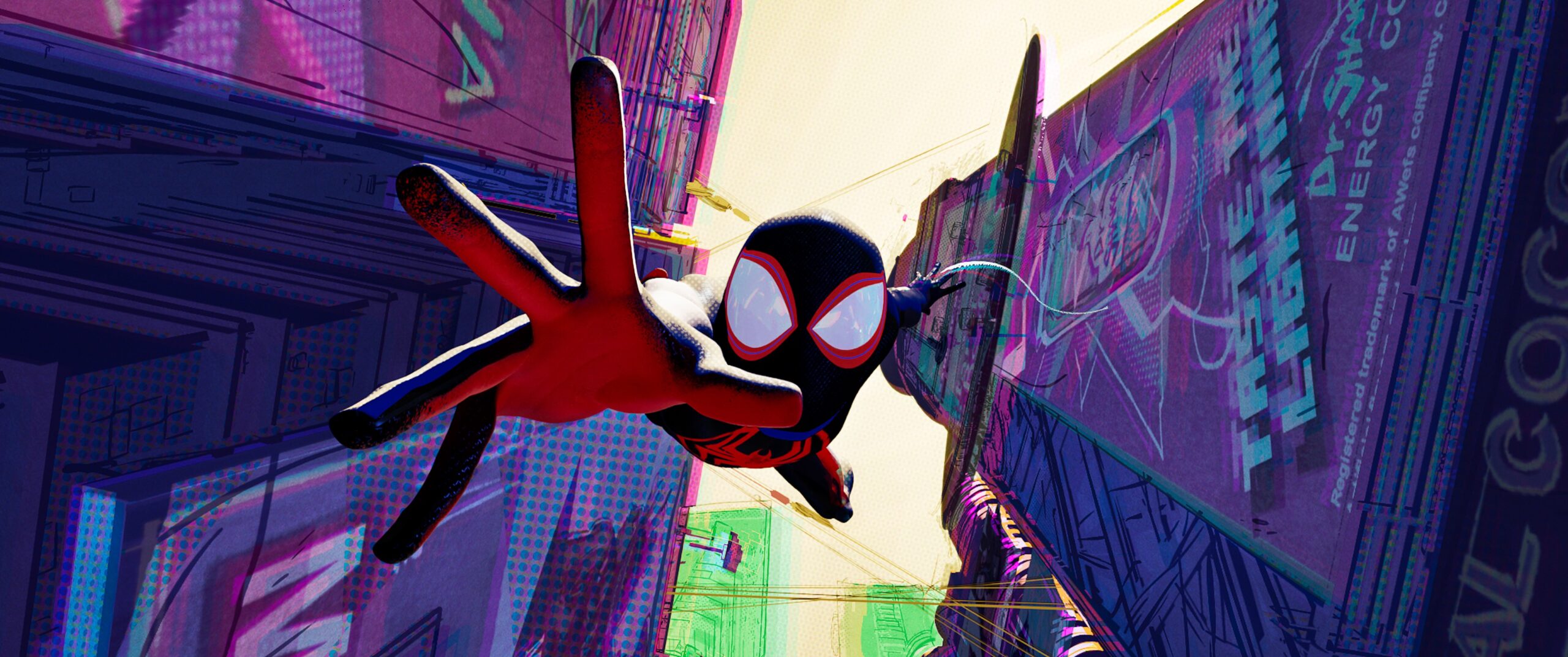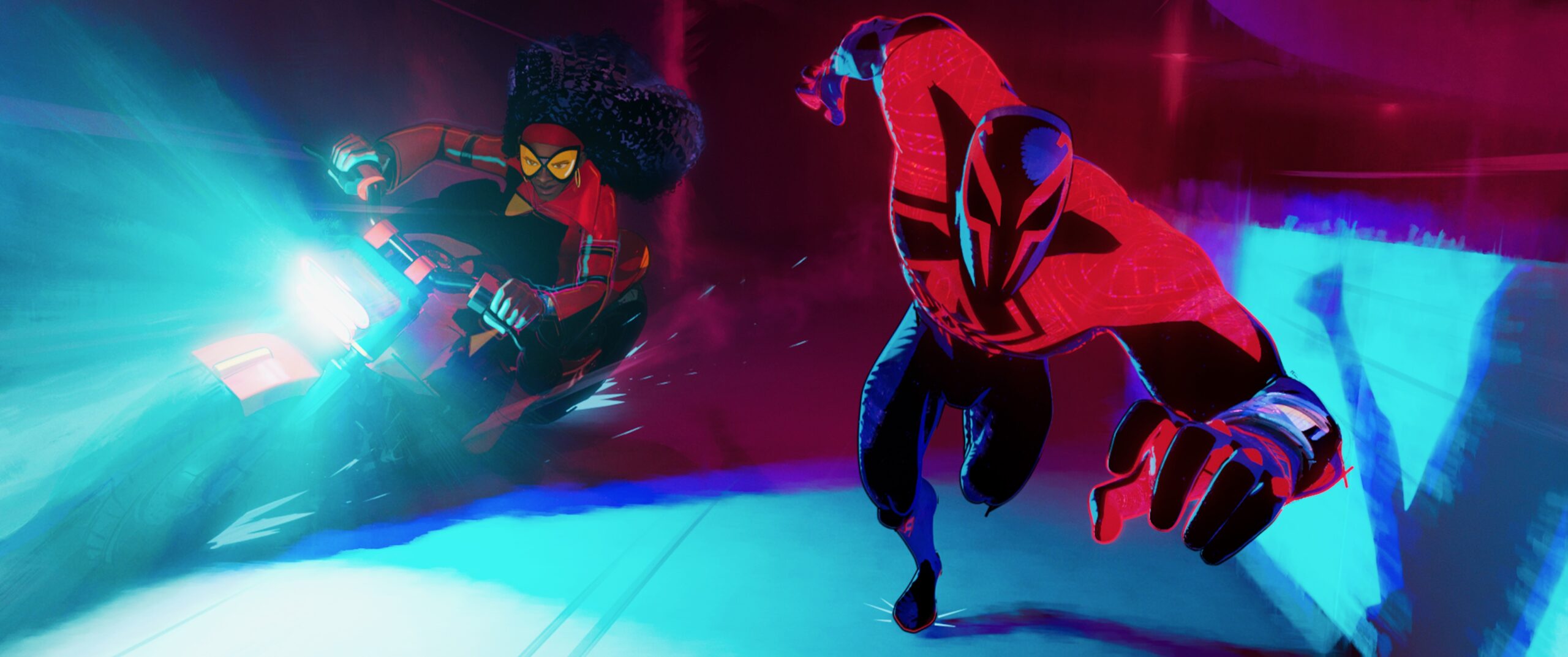The sequel to the Oscar-winning original is mature, wilder, and more ambitious—but it’s ultimately one half of a movie.
Akhil Arora, a member of the Film Critics Guild and a Rotten Tomatoes-certified film critic

Almost four-and-a-half years ago, Spider-Man: Into the Spider-Verse—which would go on to pick up the Oscar for best animated movie—swung into theatres and breathed new life into comic book movies. Along the way, as I said in my review back then, it took a wacky Spider-Man storyline with an outlandish concept and transferred it onto the screen in a fascinating and fresh manner. Simply put, Into the Spider-Verse was a delight. But its sequel, Spider-Man: Across the Spider-Verse—now playing in cinemas—doesn’t have that luxury. We have seen a Spider-Verse movie already. It’s not enough to recreate that, the film needs to (somehow) go further.
Across the Spider-Verse sure has its moments—it melds live-action and animation, digs deep into comic history, and gives us meta references—but it’s also a very different film structurally, operationally, tonally, and visually. Unlike the first one, the new Spider-Verse movie is set across multiple worlds. To distinguish them from each other, the creators have given all of them a different animation style. Gwen’s world, Earth-65, is the most emotive and expressive. In one scene, the walls literally fade away to immerse us in the mood of the characters. Earth-928’s Neuva York is the most stylish and futuristic. And Earth-50101’s Mumbattan—a mix of Mumbai and Manhattan—is dizzying, combining the chaos of India with the verticality of New York’s prized borough. That said, it lacks cultural specificity.
Across the Spider-Verse is an incomplete movie
More importantly, Spider-Man: Across the Spider-Verse is a more considered and more adult movie. With Miles growing up, the film deals with more weighty stuff—it’s about responsibilities and not taking things lightly. And just before it wraps, it pushes into darker territory, something I expect the sequel to delve into more. Speaking of the sequel, Across the Spider-Verse knows that its story spans two movies. A second sequel, Spider-Man: Beyond the Spider-Verse, originally titled Across the Spider-Verse (Part Two), is scheduled to release in March 2024. That’s why “Part One” is deliberately slowed down—at 2 hours and 20 minutes, it’s the longest animated film ever produced in Hollywood—with scenes taking their own sweet time.
While Into the Spider-Verse was super quick and light on its feet, its follow-up is in no rush—on one hand, that’s good for character work, because you’re present in the moment more. But on a big-picture level, it suffers as Across the Spider-Verse is an incomplete movie. (Not as bad as Dune though, which literally cut in the middle of a scene.) So as brilliant and funny as it might be, Across the Spider-Verse doesn’t hold a candle to its predecessor because it’s very much unfinished and hence unsatisfying—and that’s a huge shame.
Across the Spider-Verse: the plot
Sixteen months on from the events of Into the Spider-Verse, Miles Morales (Shameik Moore) is struggling to balance his two lives: being the one and only Spider-Man (on his Earth-1610), and his parents’ expectations of him (at school and outside). Meanwhile, over on Earth-65, Gwen Stacy (Hailee Steinfeld) is struggling to move on from the death of her Peter and repair her bond with her cop dad (Shea Whigham). Gwen felt like a tertiary character in the original, alongside Miles and Peter B. Parker (Jake Johnson), but Across the Spider-Verse makes a lot more room for her. In fact, she’s the gateway into the bigger Spider-Verse, as we’re introduced to a whole Spider-Society run by Miguel O’Hara (Oscar Isaac).
Seemingly afraid of pushing away those who haven’t seen Into the Spider-Verse, bits of the early running here are constructed to include expository bits that reintroduce the characters and recap what happened. It’s not elegantly handled and organically done, which can be a little irritating. A reason it partly stands out is that Across the Spider-Verse is also not as constantly funny. (The first film is a high bar to clear, to be honest.) But there’s still plenty here to keep you occupied, especially once Gwen gets an assignment that reunites her with Miles.

The common thread is the new villain, The Spot (Jason Schwartzman), who also contributes to the film’s humour quotient since he’s figuring out his powers and agenda. A clueless villain makes for a very funny villain. But while The Spot is the closest thing Spider-Man: Across the Spider-Verse has to a villain, he also spends much of the film off-screen. In some ways, he’s almost tangential to what the film is about.
Tackling similar ideas as Spider-Man: No Way Home
Like the original, the new Spider-Verse movie is more interested in the interplay of all its Spider-People. Miguel and the pregnant Jessica Drew (Issa Rae)—a Spider-Woman from another Earth—are like disapproving parents. (Gwen is so enamoured on their first meeting that she asks Jessica to adopt her.) Hobie Brown / Spider-Punk (Daniel Kaluuya) is anti-authority and too cool for school. (He’s animated in 2D and with less colour, to mimic the look of low-quality punk rock album covers.) Pavitr Prabhakar / Spider-Man India (Karan Soni) knows he’s got it good and doesn’t like to hide it.
Beyond that, Across the Spider-Verse gets into the thorny concepts of fate, destiny, storytelling, and the things that make us who we are—just as in Spider-Man: No Way Home. Made possible by the multiverse idea and defined by decades of comic books that turned origin stories into tropes, the new Spider-Man movie is an exploration of the power of canon. Did the Spider-People become who they are because of the tragedies? Or were they always destined to be who they are regardless? Across the Spider-Verse turn canon into this abstract force that holds the multiverse together. Mess with that balance and everything goes for a toss, an idea that’s briefly teased onscreen as the film wraps.
These are highly debatable topics—I’m not sure I agree with the film’s take on most of them. But we can’t even say where Spider-Verse stands until we’ve witnessed the full story. After all, Across the Spider-Verse is only half a tale.

The Easter eggs are tangential and unnecessary
Another aspect that I wasn’t fully sold on: all the Easter eggs. Beyond its narrative demands, Across the Spider-Verse also functions as a treat for long-time Spider-Man fans. In addition to the ones already revealed in the trailers, the sequel features nods to the history of the comic book character, spanning animation, live-action, and video games. At times, it’s even an attempt to satisfy certain corners of the Internet, giving the fandom something they’ve desired but not found elsewhere. I’m sure it’ll please a select few—as it did in my screening—but I don’t believe they add anything to the movie other than “Hey, we see and recognise all Spider-Man fans.” Look, I’ve no problems with this if it’s organically woven into the story, as Into the Spider-Verse did. But here they stick out and feel unnecessary.
And while some are in your face, others will no doubt require multiple viewings. This is also true of how Across the Spider-Verse extends the comic book aesthetics—in addition to all the squiggly lines, panel-based animation, and the use of onomatopoeia (now even in Hindi), the new Spider-Man movie gives us notes in the corner of the frame, which provide necessary context on things in-frame. This applies to characters, dialogue, or at times, even jokes. But Across the Spider-Verse moves so quickly that there’s no way to catch all of them.
Across the Spider-Verse shoots itself in the foot
Ultimately though, there’s going to be a bigger reason to rewatch this movie—when the next one rolls around, I’ll need to refresh myself on where the plot leaves us. For those who watch the Spider-Verse trilogy a few years from now, this won’t matter. Everything will be a click away. But in the here and now, this is very frustrating. Here was the opportunity to deliver a note-perfect sequel, but they’ve shot themselves in the foot by splitting it into two. Spider-Man: Across the Spider-Verse is still a mature, wilder, and more ambitious sequel—one that reminds us what animation is capable of and should aspire to be—but it’s not as wholly impressive as its predecessor.
I had a smile plastered on my face walking out of Into the Spider-Verse. Walking out of Across the Spider-Verse, I couldn’t help but feel a little letdown.
Spider-Man: Across the Spider-Verse released June 1 in India and June 2 in the US. In India, Across the Spider-Verse is available in English, Hindi, Bengali, Gujarati, Kannada, Malayalam, Marathi, Punjabi, Tamil, and Telugu.
- Every Indian Netflix original movie, ranked – October 25, 2024
- The opening night of the 2024 MAMI Mumbai Film Festival was a joke – October 19, 2024
- Agatha All Along episode 5: what time is it out? – October 9, 2024




What do you think?